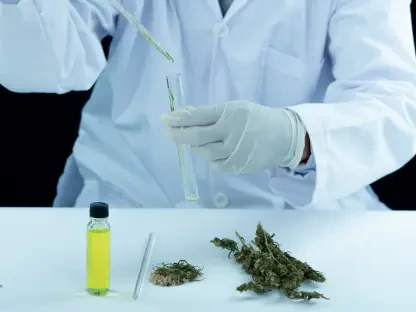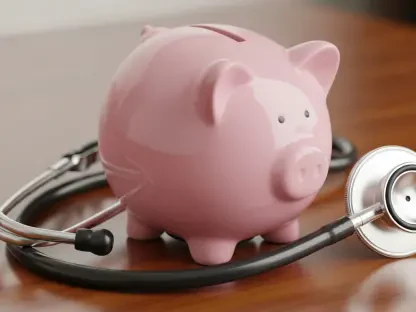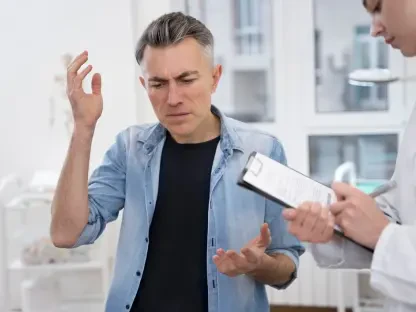In Mississippi, a state burdened by one of the highest obesity rates in the nation at nearly 40% of adults, a groundbreaking policy to cover weight loss drugs through Medicaid sparked hope for a healthier future, yet it remains just out of reach for most. Picture a lifeline extended to thousands struggling with severe health risks, only to find that since the state’s decision two years ago to include GLP-1 receptor agonists—medications proven to help shed significant weight—under Medicaid, the promise of transformation has clashed with a harsh reality. Far too few have accessed this benefit, leaving a critical public health tool underutilized in a region desperate for solutions. This gap between intention and impact demands a closer look at what’s holding back progress in the heart of obesity country.
The significance of this issue cannot be overstated. Mississippi’s battle with obesity fuels staggering rates of diabetes, heart disease, and shortened lifespans, placing immense strain on both individuals and the healthcare system. With Medicaid covering a substantial portion of the state’s low-income population, the choice to fund these innovative drugs was seen as a potential game-changer—not just for personal health outcomes but also for long-term cost savings by curbing obesity-related conditions. Yet, as barriers persist and uptake remains minimal, the story unfolding here reflects broader challenges in public health policy, access to care, and the struggle to turn bold ideas into tangible results.
A Missed Opportunity in a Struggling State
Mississippi stands as a stark symbol of America’s obesity epidemic, where the weight of health disparities is felt daily. In communities across the state, the physical and economic toll of this crisis is visible—grocery stores stocked with processed foods, limited access to fresh produce, and a healthcare system stretched thin. When the state opted to cover GLP-1 drugs through Medicaid two years ago, it was a rare moment of proactive policy in a region often left behind. These medications, known for their ability to reduce body weight by up to 20% in clinical trials, offered a beacon of hope for thousands of eligible enrollees.
Yet, the numbers paint a disappointing picture. Despite the availability of this benefit, only a small fraction—about 2% of eligible adult Medicaid recipients, or roughly 2,900 individuals—have received these drugs in the initial rollout period, costing the state $12 million. This low participation rate raises alarms about whether the policy can truly address the scale of need. In a state where obesity touches nearly every family, the failure to connect more people with this treatment represents a profound missed chance to alter the trajectory of public health.
The ripple effects extend beyond statistics. Each person unable to access these drugs is a missed opportunity to prevent chronic illnesses that burden both lives and budgets. As policymakers and advocates grapple with this shortfall, the question looms large: how can a state so deeply in need of intervention fail to capitalize on a tool with such proven potential? The answers lie in a web of systemic challenges that must be unraveled to understand the full scope of this policy’s struggle.
The High Stakes of Obesity and Medicaid’s Burden
Obesity in Mississippi isn’t just a personal struggle; it’s a public health emergency with cascading consequences. Ranking among the highest in the nation for obesity prevalence, the state sees its residents face elevated risks of life-threatening conditions like Type 2 diabetes and cardiovascular disease. These health challenges drain resources, with billions spent annually on treating preventable illnesses tied to excess weight. The urgency to act is clear, as each year of inaction deepens the crisis for communities already grappling with poverty and limited healthcare options.
Medicaid, serving as a critical safety net for many low-income residents, took a significant step by becoming one of just 13 states to cover GLP-1 drugs for weight loss. This decision was grounded in a dual purpose: to improve individual well-being and to reduce the long-term financial load of obesity-related care. By investing in prevention through these medications, the state aimed to cut down on hospital stays and expensive treatments down the line, a strategy backed by studies showing substantial health improvements with sustained weight loss.
However, the program’s restrictive eligibility rules—often excluding adults without dependent children and setting tight income limits—already narrow the pool of who can benefit. Even among those who qualify, the path to accessing this coverage remains fraught with obstacles. The intersection of a dire health crisis and a strained public insurance system underscores why this policy’s success is so vital, yet so elusive, in a state where every intervention counts.
Barriers Blocking Access to Life-Changing Drugs
Digging into the reasons behind the low uptake reveals a maze of logistical and systemic hurdles. National shortages of GLP-1 drugs have created a bottleneck, leaving pharmacies unable to meet demand even for those with prescriptions. This scarcity hits hardest in underserved areas, where supply chains are already fragile. For a state like Mississippi, reliant on consistent access to make this policy work, such disruptions are a major setback to reaching those in need.
Beyond supply issues, the prior authorization process adds another layer of frustration. Doctors must navigate extensive paperwork to prove a patient’s obesity level, outline treatment plans, and document progress, a time-consuming task that often deters providers from even initiating the process. Patients, too, grow discouraged by delays and denials, with many giving up before receiving approval. This administrative burden acts as a gatekeeper, filtering out all but the most persistent or well-supported individuals.
Awareness, or the lack thereof, further compounds the problem. Many Medicaid enrollees remain unaware of this benefit, while some healthcare providers lack the information needed to guide patients through the system. Geographic disparities exacerbate the issue—regions like the Mississippi Delta, where obesity rates approach 50%, show almost no participation compared to southern or central parts of the state. These combined barriers—shortages, red tape, and uneven outreach—form a formidable wall between policy and practice, stifling the impact of what could be a transformative health initiative.
Real Stories of Triumph and Disappointment
For the few who have navigated the obstacles, the results of GLP-1 drugs are nothing short of remarkable. April Hines, a Mississippi resident, shed over 200 pounds, describing a renewed sense of energy that allowed her to reclaim daily activities once thought impossible. Her story is not unique; others, like Lauren Scott and Michelle Howell, have shared how the medication curbed relentless appetites, leading to significant weight loss and a better quality of life. These personal victories highlight the profound potential of the drugs when access is granted.
Healthcare providers on the front lines echo this optimism. Dr. William Rosenblatt, a practicing physician in the state, calls these medications “game-changers,” emphasizing their ability to tackle the root causes of chronic conditions rather than just symptoms. Dr. Virginia Crawford agrees, noting that patients often see improvements in blood pressure and cholesterol alongside weight reduction. Backed by research, such as a 2021 study in the New England Journal of Medicine showing sustained weight loss benefits, the clinical case for these drugs is strong, fueling hope among medical professionals for broader reach.
Yet, not all perspectives align on this approach. Some, including high-profile figures like Health and Human Services Secretary Robert F. Kennedy Jr., argue that pharmaceutical solutions should not overshadow lifestyle changes like diet and exercise. This skepticism reflects a broader debate about whether public funds should prioritize costly drugs over preventive education. The clash of enthusiasm and caution among stakeholders underscores the complexity of integrating such treatments into a strained healthcare framework, leaving many to wonder if the current path is sustainable.
Strategies to Close the Coverage Gap
Turning this policy into a success demands targeted solutions to address Mississippi’s unique challenges. Streamlining the prior authorization process is a critical first step—reducing paperwork and providing clear, accessible guidelines can lessen the burden on providers, encouraging more to participate. Digital tools or support staff dedicated to handling approvals could further ease this bottleneck, ensuring patients aren’t lost in bureaucratic delays.
Education stands as another pillar for progress. Statewide campaigns aimed at both Medicaid enrollees and healthcare professionals, particularly in underserved areas like the Mississippi Delta, are essential to raise awareness of the benefit. Partnering with community organizations and local clinics to spread the word can bridge the information gap, while training for doctors on the drugs’ benefits and application processes could boost prescriptions. Tailored outreach must prioritize regions with the highest obesity rates to maximize impact where it’s needed most.
Finally, tackling drug shortages and funding constraints requires collaboration beyond state borders. Working with federal agencies and pharmaceutical companies to secure a steady supply of GLP-1 medications is non-negotiable, as is advocating for sustainable Medicaid financing amid looming federal cuts projected at $911 billion over the next decade. Policymakers must explore innovative models, such as value-based pricing, to balance the high upfront costs—often around $1,000 per month per patient—with long-term health savings. These combined efforts offer a roadmap to ensure that this critical intervention reaches far more than the current fraction of eligible individuals.
Reflecting on a Persistent Challenge
Looking back, the journey of Mississippi’s Medicaid coverage for weight loss drugs reveals a stark contrast between ambition and execution. The initial decision to fund GLP-1 medications stood as a bold move against the tide of obesity, yet the reality of reaching only 2% of eligible adults underscores deep-rooted flaws in delivery. Stories of transformation from those who accessed the drugs clash with the silence of countless others still waiting, painting a picture of both progress and profound gaps.
The barriers—ranging from drug shortages to administrative hurdles—expose systemic weaknesses that no single policy can overcome without concerted effort. Voices of patients and providers alike echo a shared frustration, tempered by the undeniable impact on lives changed for the better. As the state wrestles with these challenges, the looming shadow of national funding cuts and policy debates adds layers of uncertainty to an already complex issue.
Moving forward, actionable steps emerge as the clearest path to resolution. Simplifying access processes, amplifying outreach in neglected regions, and securing stable resources must guide future efforts. Collaboration across local, state, and federal levels remains essential to turn this policy from a faltering experiment into a scalable solution. Only through such targeted action can Mississippi hope to bridge the divide between promise and reality, ensuring that a lifeline once offered becomes a true source of health for all who need it.









